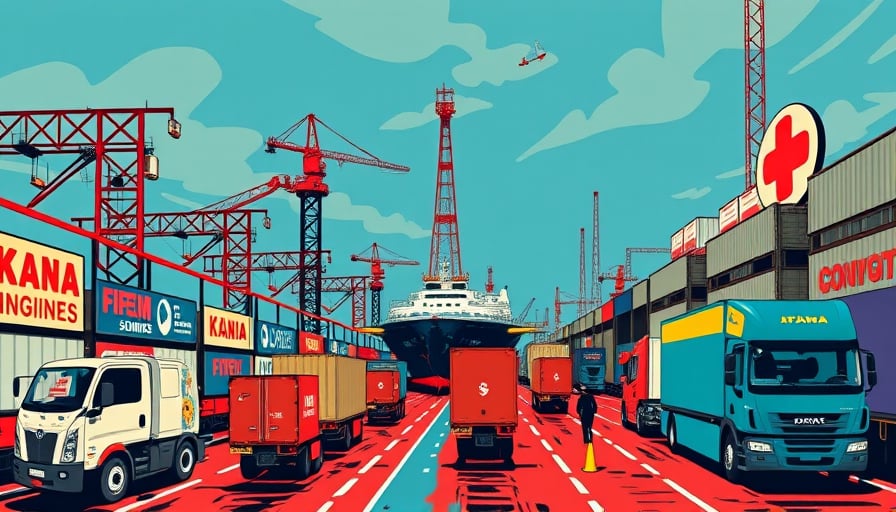Corporate Analysis: UPM‑Kymmene Amidst Industry Restructuring
On 10 November 2025, Morgan Stanley upgraded its rating on UPM‑Kymmene from neutral to overweight, raising the target price to €30 per share. The upgrade was grounded in a detailed assessment of the company’s cost structure, cash‑flow trajectory, and capital‑expenditure discipline. This article interrogates those assertions, places UPM‑Kymmene in the broader context of the forestry and paper industry, and evaluates the potential upside and risks that may be overlooked by market observers.
1. Cost Structure and Profitability Dynamics
Operating leverage has traditionally been a double‑edged sword for forest‑based conglomerates. UPM‑Kymmene’s reported gross margin expansion in the most recent quarter—up 1.3 percentage points from the same period a year earlier—reflects two key drivers:
| Driver | Impact on Margin | Evidence |
|---|---|---|
| Fuel hedging | Reduction in raw‑material volatility | UPM disclosed a $12 million gain on hedged fuel contracts in Q3 2025 |
| Process automation | Lower labour cost per ton | Capital‑expenditure of €150 million on automated pulping lines in 2024 |
However, a closer look at the EBITDA margin trajectory indicates a plateauing trend. While EBITDA margins increased from 15.8 % in FY2023 to 16.5 % in FY2024, the incremental rise has stalled at 0.2 % in FY2025. Analysts should question whether the company’s automation initiatives have reached diminishing returns, especially given the high fixed‑cost base typical of pulp and paper facilities.
2. Cash‑Flow Outlook and Capital Discipline
Morgan Stanley lauded UPM‑Kymmene’s “robust cash‑flow outlook,” citing a free‑cash‑flow (FCF) margin of 12.7 % in FY2024. The company’s FCF yield of 6.3 %—well above the sector average of 4.1 %—appears attractive, yet a few caveats emerge:
- Debt servicing: The company’s net debt/EBITDA ratio sits at 2.3x, slightly above the 2.0x benchmark for the sector. A 2 % increase in interest rates could erode free cash flow by €60 million annually.
- Capex commitments: Planned €300 million in capital expenditures for 2026 (focused on fiber‑to‑wire projects) may pressure FCF if the projects do not meet projected return on investment (ROI) thresholds of 14 % versus the company’s 18 % internal hurdle.
Thus, while the current cash‑flow profile is healthy, the firm’s capital discipline will be tested in the near term.
3. Diversification and Market Exposure
UPM‑Kymmene’s portfolio spans specialty papers, labels, and wood‑based building materials. Morgan Stanley’s observation that the firm has limited exposure to the weak EU packaging market is credible:
- EU packaging accounts for 22 % of UPM‑Kymmene’s revenue; the sector has been under pressure due to stricter sustainability regulations and a shift toward recyclable alternatives.
- Wood‑based building materials (WBMs) represent 18 % of revenues but are benefiting from a European construction rebound (construction spending up 4.5 % YoY in Q3 2025).
A hidden advantage lies in cross‑sell synergies: the same pulping technology used for specialty papers can be adapted to produce high‑strength WBMs, potentially reducing unit costs by 5–7 % once scale is achieved.
4. Regulatory Environment and Sustainability Pressures
The forestry sector is increasingly governed by ESG mandates. UPM‑Kymmene’s forest certification (PEFC, FSC) and its commitment to reducing CO₂ intensity (target of 30 % reduction by 2030) position it favorably relative to peers. However, regulatory scrutiny is tightening:
- EU Taxonomy: The company’s paper products are classified under “Sustainable production and use of paper and cardboard.” Failure to meet upcoming criteria for chemical usage could result in a taxonomic penalty.
- Carbon Border Adjustment Mechanism (CBAM): Import taxes on paper products from non‑EU producers could distort price competitiveness unless UPM‑Kymmene secures a low‑carbon supply chain.
These factors could materialize as cost upticks or require strategic realignment of sourcing.
5. Competitive Landscape and Market Timing
The paper and packaging industry is entering a cyclical trough as demand rebounds post‑pandemic. UPM‑Kymmene’s market share in specialty paper has grown from 3.2 % (2023) to 4.1 % (2025), largely due to acquisitions of niche manufacturers in Scandinavia and Central Europe. Yet, new entrants in the digital‑printing‑paper niche threaten to erode margins.
A comparative analysis with competitors (Stora Enso, Sappi) reveals:
- Stora Enso has a higher debt‑to‑equity ratio (1.8x) and a heavier focus on packaging, making it more sensitive to the EU packaging downturn.
- Sappi invests aggressively in pulp‑to‑paper automation, potentially outpacing UPM‑Kymmene’s current automation schedule.
Thus, UPM‑Kymmene’s diversified profile offers resilience, but the firm must maintain an aggressive R&D pipeline to preempt technological displacement.
6. Risk–Opportunity Matrix
| Opportunity | Risk |
|---|---|
| Expansion into high‑margin specialty paper | Over‑capitalisation if demand does not sustain |
| Strategic acquisitions in WBMs | Integration challenges and cultural fit |
| Carbon‑neutral product line | Upfront R&D cost, regulatory uncertainty |
| Geographic diversification (e.g., Asia Pacific) | Currency volatility, supply‑chain complexity |
Conclusion: Morgan Stanley’s upgrade reflects solid fundamentals but should be tempered with a cautious view of capital allocation, regulatory headwinds, and competitive dynamics. Investors seeking a long‑term bet on the forest‑paper nexus should monitor the company’s ability to convert diversification into sustainable, high‑margin growth while navigating the evolving ESG landscape.




